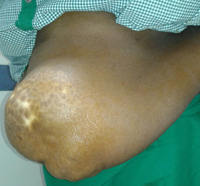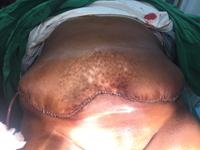
In general, a hernia refers to a condition that arises when an organ pushes through a weak area in the muscles or tissue that surround and contain it.
An abdominal hernia occurs when there is a tear in the inner lining of the abdominal wall (the outer layer of muscle, fat and tissue that extends from the bottom of the ribs to the top of the thighs), causing a bulge in the abdominal wall where the organs protrude. The bulge can be either reducible, which means that by applying slight pressure to the area, you can feel the organs being pushed back into the abdominal cavity and the hernia will flatten and disappear, or non reducible, which means the fat or tissue cannot be pushed back into the abdomen and the hernia will not flatten. Whether a hernia is reducible depends on how far it protrudes through the abdominal wall and how tightly it is held by the abdominal muscles.
Hernias are repaired surgically with a simple surgical procedure. Without corrective surgery the condition may lead to a strangulation. This is where the organ or intestine that is protruding through the abdominal wall may have its blood supply cut and die if it becomes tightly trapped. Strangulation of an intestine causes extreme pain, can block digestion and may even cause gangrene in that area of intestine. In this case, emergency surgical repair is required.
A hernia can develop in anyone, from a newborn baby to a senior citizen. The following may increase risk of developing a hernia by straining or increasing pressure on the abdominal wall:
- A chronic cough, such as smoker's cough
- Your browser may not support display of this image. Obesity
- Your browser may not support display of this image. Straining during bowel movements or while urinating
- Your browser may not support display of this image. Pregnancy
- Your browser may not support display of this image. Straining to lift heavy objects
- Persistent sneezing, such as that caused by allergies
This type of hernia occurs as a result of a weakness in the muscles of the upper-middle abdomen, above the navel. Men are about three times more likely to have an epigastric hernia than women, and the majority occur in people between 20 and 50 years of age.
Umbilical Hernia
Another natural area of weakness in the abdomen is the navel, which, like the internal ring, is made up of tissue that is thinner than that in the rest of the abdomen. These hernias can occur in babies, children and adults.
Femoral Hernia
A femoral hernia occurs in the area between the abdomen and the thigh, and appears as a bulge on the upper thigh. This type of hernia is more common in women than men.
Incisional Hernia
A type of hernia called incisional can occur at the site of an incision from a previous surgery. The fat or tissue pushes through a weakness created by the surgical scar. An incisional hernia can occur months or years after the initial surgery.


Before After
A hernia usually first becomes noticeable as a bulge somewhere in the abdomen or pelvic area or in the scrotum for men. If the bulge is reducible, it may enlarge when the person is standing and become smaller when he or she lies down. The changes in the hernia's size are due to the increased pressure on the abdominal wall caused by gravity when we stand. A hernia may cause sharp or dull pain that worsens when having a bowel movement, during urination, or while lifting a heavy object.
The pain might worsen as the day progresses, especially with long periods of standing, because of gravitational pressure. Nonprescription drugs such as aspirin and acetaminophen may relieve minor discomfort. In the case of a strangulated hernia that contains intestine, the herniated section of intestine might become blocked. This blockage may cause blood in the stool, constipation, fever, severe pain, vomiting and even shock. If these symptoms are experienced, emergency medical attention is needed. Even with suspected hernias that do not cause these symptoms, it is best to schedule an appointment with a doctor to avoid these complications. The doctor will probably want to perform a physical examination and discuss the patient's symptoms and medical history to determine if a hernia has developed.
Open and Laparoscopic Hernia Repair
Hernia repair surgery is an effective long lasting treatment for hernias. Successful surgery will end discomfort, repair the hernia, and stop the hernia from progressing.
In many patients in the last decade Abdominal Wall Hernia were done by the Open Incision Technique , but in last few years Laparoscopic Hernia repair through small Key hole surgery .
The surgical procedure for hernia repair is a Laparoscopic procedure in which a fiber optic viewing tube and special instruments are used to repair the hernia without making a large incision. This procedure requires less recovery time than traditional hernia repair surgery. The surgery will result in three small incisions, one is usually located in the naval and one on each side of the tummy just above the waistline. The surgery will result in scars about 10 mm in length. These scars will fade in time.
In preparation for the surgery, blood tests, an electrocardiogram (EKG), and/or a chest X-ray may be undertaken depending on the age and fitness of the patient. The patient may be required to stop medications before surgery, including aspirin, because they thin the blood and reduce the post operative healing capacity also some drugs may have dangerous interactions with anesthetics or increase the risk of abnormal bleeding.
The patient may be requested to stay a few days after surgery so that they may be carefully evaluated and returned home in good health. After hernia repair surgery, time should be allowed for rest and recovery at home.
General Anesthesia or Regional Anesthesia .
Normally General Anesthesia is used. It is a safe, common method of ensuring that no pain is felt while the hernia is repaired. There are some risks involved with general anesthesia, especially if the patient has significant medical problems, which can factor into the choice of anesthetic. These risks will be discussed with the patient. If a general anesthetic is chosen, the patient should not eat or drink anything after midnight of the night preceding the surgery.
During surgery, the surgeon will make an incision at the hernia and either move the contents within the protruding hernia back into the abdominal cavity or remove the contents, especially if the protrusion includes strangulated intestines. In order to repair the hernia, the surgeon will insert a synthetic mesh behind the weekend abdominal wall. In time the synthetic mesh will grow into the weakened tissue forming a strong barrier preventing reoccurrence of the condition. The repair should be permanent and not require any further surgery.
After surgery, the patient may receive fluids and pain-relieving medication through an intravenous (IV) tube for a few hours.
Recovery time will depend on the health of the patient and the type of surgical repair that was performed. The patient should be able to walk after 24 hours however several days rest is needed as there will be some discomfort, swelling, brusing and pain. After a few days once the patient is back at home, they may try to slowly ease back into normal activities. Light activities can usually be resumed in a few days.
How soon the patient can return to work depends on the type of job that he or she has. A job that is very physically demanding may require more recovery time before returning than a job that does not require putting strain on the body. It is recommended that no strain be put on the body for 6 - 8 weeks after surgery. Light exercise, such as walking, helps increase blood flow and promotes healing.
Lifting should be avoided, but if it is absolutely necessary, only manageable objects should be attempted and lifting should be done with the legs, not the back. Activities such as driving and sex can also strain the incision. The patient should ask when these activities can be resumed. Pain medications may be prescribed for the first few days at home. A patient should never drive while taking pain medications.
A doctor should be notified immediately if any of the following symptoms are experienced after the surgery:
- Fever
- Your browser may not support display of this image. Difficulty Urinating
- Your browser may not support display of this image. Excessive Bleeding
- Your browser may not support display of this image. Redness in the Area of the Incision
- Your browser may not support display of this image. Excessive Tenderness or Swelling
- Your browser may not support display of this image. Severe or Increasing Pain
After a hernia has been treated there are certain things that can be done to decrease the risk of recurrence. The following suggestions can help reduce the risk of a hernia recurring:
- Maintaining a healthy weight
- Your browser may not support display of this image. Exercising to tone the muscles of the abdomen
- Your browser may not support display of this image. Receiving medical help for chronic constipation, allergies or a chronic cough
- Your browser may not support display of this image. Eating high-fiber foods
- Avoiding the risk factors mentioned earlier


 copy.jpg)

.jpg)